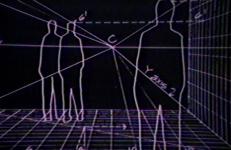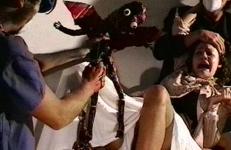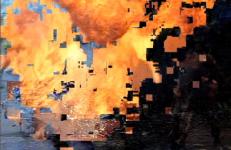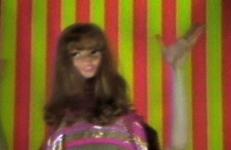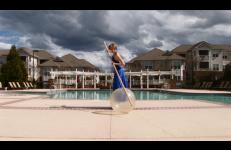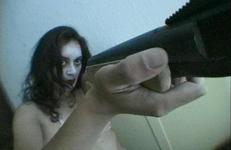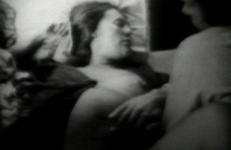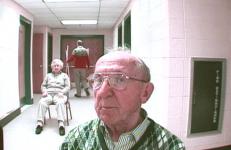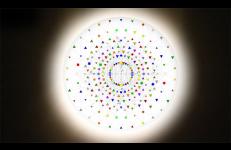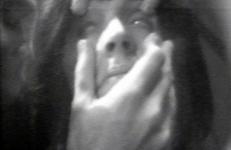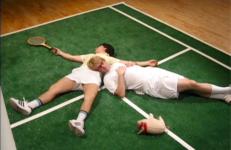In this episode of The Live! Show, hosted by Jaime Davidovich, Eric Bogosian brings seven characters to life in seven minutes, Michael Smith plays the best driver in the world, Mitchell Kriegman offers a helping hand during the show’s popular call-in segment, and Louis Grenier demonstrates the organic face lift viewers can do at home.
Performance
In Performer/Audience/Mirror, Graham uses video to document an investigation into perception and real time informational "feedback." The performance is doubly reflected back to the audience by the artist's lecturing, and the architectural device of a mirrored wall. Graham has written extensively on how video, which can deliver information in real time, functions semiotically as a mirror.
This tape examines the meaning, impact, and future of the early-1980s avant-garde through interviews with artists (Scott B., Robert Longo, Walter Robinson, Michael Smith), an art dealer (Helene Winer, Metro Pictures), a museum director (Marcia Tucker, The New Museum of Contemporary Art), and an art historian (Roselee Goldberg). “Whenever you feel confident that you know what’s happening at the outside edge, something’s always happening that you don’t know about. The avant-garde, if it exists at all... is determined by the artist, not the peripheral people like myself,” Tucker says.
The Jersey Devil lives again in this work the students and I mounted (or disrobed) for skeptical scrutiny.
The Physical Impossibility of Life in the Mind of Someone Dead is Chapter 2 of Mysterium Cosmographicum.
I can’t live if living is without you, he said as his tear-stained cheek glistened in the glare of the klieg lights. Slowly, he tightened his finger around the trigger . . . .
An audio mix assembled as part of a memorial for the storyteller and very old friend, Spalding Gray, who lost himself in New York Harbor in 2004.
This title is audio only.
Produced in 1974, and restaged in 2002, near Pilot Butte in southwestern Wyoming.
The artist makes a pilot light using ice, which he has fashioned into a magnifying lens to start a small fire.
This piece was originally shot using 1/2" open reel video and later incorporates edits from DV video.
A philosopher and intermedia artist, Adrian Piper focuses on xenophobia, racism, and racial stereotyping
“As a black woman who can 'pass' and a Professor of Philosophy who leads a double life as an avant-garde artist, Piper has understandably focused on self-analysis and social boundaries. Over the years her work in performance, texts, newspaper, unannounced street events, videos, and photographs has developed an increasingly politicized and universalized image of what the self can mean.”
The artist uses wire to suspend a block of ice in a pit-like industrial space. He swings the ice block, which is lit by a similarly swinging light bulb on a separate pendulum.
This science fiction adventure centers on the interaction between a crew of Earthmen and their seduction by the love-hungry Amazons of the red planet, Mars. The tale is brought to life with all the opulence that an $800 budget can produce and the young cast of non-actors live up to their fullest foibles as the plot thickens with a mix of romance and wartime action intertwined with a musical number or two. The ambitions were high and the necklines low in this effects-laden tribute to pulp fiction fantasy and intergalactic intercourse.
In this early Tom Rubnitz, Barbara Lipp and Tom Koken collaboration, "Frieda" performs her rap song with a bevy of dolls as back-up singers and dancers. Features rock-bottom production values and song lyrics by Barbara Lipp and Tom Koken.
In this early Tom Rubnitz, Barbara Lipp and Tom Koken collaboration, "Frieda" performs her rap song with a bevy of dolls as back-up singers and dancers. Features rock-bottom production values and song lyrics by Barbara Lipp and Tom Koken.
In this early Tom Rubnitz, Barbara Lipp and Tom Koken collaboration, "Frieda" performs her rap song with a bevy of dolls as back-up singers and dancers. Features rock-bottom production values and song lyrics by Barbara Lipp and Tom Koken.
Plowman's Lunch is called a documentary because its intent was to explore actual occurrences—be these the building of the work, or what befalls the players. It still uses an open form, but the characters are more developed; they have "names," and some of the scenes were truly dangerous for them to produce. As in the other films (with the exception of Done To) there is a nucleus of three characters—two women (Boris and Jamiee), and one man (Steentje, a tranvestite/hermaphrodite). The music, composed expressly for the piece, is harmonious with its developments.
Pochonovela is a bilingual, bicultural blend of Latin America’s and the United States’ most popular television genres—the telenovela and the sitcom, respectively. The humor and madness of life in East Los Angeles are captured here in performances by members of the Los Angeles-based comedy troupe, Chicano Secret Service, and other U.S. Latino actors. This provocative comedy touches on political, social, cultural, linguistic, and family issues attendent to the cross cultural life of Mexican Americans living near or on the border—both psychologically and geographically.
A man explains global currency markets without the help of his formerly trusty rockin’ talkin’ pony, who is missing. Without the pony, the world is as disorientating as it is depressing. The audience is invited to help make order of the chaos.
This title is also available on Ben Coonley: Post Pony Trilogy.
This real-time video-meets-digital-animation trilogy of shorts features the highly excited and mildly delusional Joe Gibbons, whose springboard becomes a surfboard as he fantasizes about his days as a lifeguard in 1963, when the young Brian Wilson would sit and jot down the songs he would sing while saving lives.
Skating softly, but carrying a big stick, performer Kristin Elliott engages in an interlocking series of skits involving simple, slapstick activities performed by a pristine outdoor pool and in a venetian blind windowed corner of a room. Bodies of water - an aquarium is transported into the interior space - become a major link between these two settings. These containers of water end up functioning as both wombs and graves.
In Post Queer Pride 93, Brenda and Glennda attend the New York City Queer Pride Parade. This video marks the return of Brenda after her relocation to Florida, and Glennda interviews her about the queer scene and gay activism in the South. At the parade, they conduct interviews with queers about the postqueer movement, the leather and SM scene, feminism, and capitalism.
As if trapped inside a nightmare, the main protagonist of Poster Girl is haunted by disturbing visions, thoughts and fantasies, which the viewer is privy to. She is joined at various points in the video by another woman, whose role in the narrative remains unclear – is she meant to function as a guardian or a demon? The video further complicates the matter by representing both women as simultaneously wounded and wounding, inviting and threatening, vulnerable and menacing.
Over grainy, black and white images of a woman giving birth, Montano reads the story of a nun’s sexual self-discovery—recounting Sister Joan’s growing awareness of her body’s sensuousness and sexuality. Primal Scenes is an excellent example of women’s erotica, focusing on a woman’s experience of her body as both sexually powerful and deeply mysterious.
A video adaptation of James Joyce’s Ulysses shot at the Parkville Senior Center, Connecticut, with the seniors reading the lines from cue cards. The piece addresses society, war, and personal mortality.
The Prognosticator (Or, We Are All Pythagoreans Now) is Chapter 1 of Mysterium Cosmographicum.
This extraordinary performance carries a wealth of associative meanings in the sexual dynamics of privacy and power -- man and woman pitted against each other in a struggle for mental and physical control.
"In Pryings, one of his earliest and least verbal tapes, the artist is seen trying to force open and gain entry into any and all of the orifices of a woman's face. His persistence outlasts the running time of the tape, as does the persistence of the woman under attack, who manages to persevere in her attempt to guard her metaphysical privacy."
Putting the Balls Away is a reenactment of the historic September 21, 1973, tennis match between Billie Jean King and Bobby Riggs, created for broadcast on the 35th anniversary of the original event. The Battle of the Sexes was the most-watched live sporting event at that time, and pitted chauvinist against feminist, when women tennis players demanded equal pay to that of their male counterparts. Both players are performed by Mateik, whose work wages strategic operations to overthrow institutions of compulsory gender. After each game the competitors "switch sides".





